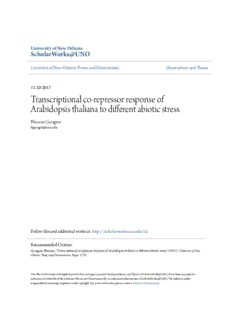
Transcriptional co-repressor response of Arabidopsis thaliana to different abiotic stress PDF
Preview Transcriptional co-repressor response of Arabidopsis thaliana to different abiotic stress
UUnniivveerrssiittyy ooff NNeeww OOrrlleeaannss SScchhoollaarrWWoorrkkss@@UUNNOO University of New Orleans Theses and Dissertations and Theses Dissertations Fall 12-20-2013 TTrraannssccrriippttiioonnaall ccoo--rreepprreessssoorr rreessppoonnssee ooff AArraabbiiddooppssiiss tthhaalliiaannaa ttoo ddiiffffeerreenntt aabbiioottiicc ssttrreessss Bhuwan Guragain [email protected] Follow this and additional works at: https://scholarworks.uno.edu/td Part of the Biology Commons, and the Biotechnology Commons RReeccoommmmeennddeedd CCiittaattiioonn Guragain, Bhuwan, "Transcriptional co-repressor response of Arabidopsis thaliana to different abiotic stress" (2013). University of New Orleans Theses and Dissertations. 1738. https://scholarworks.uno.edu/td/1738 This Thesis-Restricted is protected by copyright and/or related rights. It has been brought to you by ScholarWorks@UNO with permission from the rights-holder(s). You are free to use this Thesis-Restricted in any way that is permitted by the copyright and related rights legislation that applies to your use. For other uses you need to obtain permission from the rights-holder(s) directly, unless additional rights are indicated by a Creative Commons license in the record and/or on the work itself. This Thesis-Restricted has been accepted for inclusion in University of New Orleans Theses and Dissertations by an authorized administrator of ScholarWorks@UNO. For more information, please contact [email protected]. Transcriptional co-repressor response of Arabidopsis thaliana to different abiotic stress A Thesis Submitted to the Graduate Faculty of the University of New Orleans in partial fulfillment of the requirements for the degree of Master of Science in Biological Science by Bhuwan Guragain B.S. Purbanchal University, 2010 December, 2013 Copyright 2013, Bhuwan Guragain ! ii! Dedication This thesis is dedicated to my parents, for their great support. ! iii! Acknowledgements I thank my advisor Dr. Vaniyambadi Sridhar, for his valuable guidance and enthusiastic support. Without this support, guidance, and advice, my experiments and studies might not have been accomplished. I appreciate the support, help and inspiration of faculty of Biological Science, University of New Orleans. My special thanks to Dr. Mary Clancy for helping me with fluorescence microscopy and providing me some of the reagents whenever I needed them. My special thanks to my committee members Dr. Wendy Schluchter and Dr. Bernard Rees, who helped me a lot for my data analysis and for their guidance for my thesis. My special thanks to Sylvester Tumusiime, who showed and taught me very basics of lab environment and experiments. I would like to thank my lab mates Ms. Barsha Shrestha and Mr. Achira Weerthunga for their help, support, love and the memories. I thank Anuja Bhatta with her help for genotyping of the plants. Last but not the least I would like to thank my family members for supporting me always and every decision I make. ! iv! CONTENTS LIST OF FIGURES......................................................................................vii LIST OF TABLES........................................................................................ ix ABBREBRATION…………………………………………………………..x ABSTRACT...................................................................................................xi INTRODUCTION ..........................................................................................1 Stress responses in plants......................................................................2 Co-repressor ………………………….…………………………...….3 The co-repressor: leunig …….…………………….………..………...4 SEUSS and SEUSS like transcription factors………………...………7 Co-repressor and flower development………………………………..9 Transcriptional repression by chromatin Modification…………..….10 Gene repression under abiotic stress…………………………..…….11 Trangenesis……………………………………………….....………15 Ti Plasmid……………………………………………….......………15 Protein interaction study……………………………………………16 Research goal……………………………….………………………17 MATERIALS AND METHODS..................................................................18 Yeast two hybrid screening……………………………………….…18 Plant growth……………………………...………………………….19 Leaf DNA extraction…………………………...……………………19 Mutant identification……………………………...…………………20 Amplification of promoter region and cDNA……………………….21 cDNA of SLK1, SLK2 and LUH…………………………......………….24 Generation of transgenic plants…………………….………………..24 TOPO cloning………………………………………………...24 ! v! Gateway cloning………………………..…………………….25 Plant vectors for promoter analysis……………………...…...28 Vectors to study localization of proteins……….…………….28 LUH flag tag………………………………….………………28 Transformation of Agrobacterium……………………………31 Plant transformation and selection……………………………31 GUS assay………………………….......……………………..32 GUS staining……………………………………………….…33 Transient expression analysis of co-repressors……………….34 RESULTS…………………………..………………………………………35 Yeast two hybrid screening………………………………………….35 Genotyping of plants………………………………………………...37 Isolation of SLK1/LUH3 double mutants…………………………...37 Cloning and creation of transgenic lines…………………………….41 GUS activity………………………………..………………………..49 Study of protein localization………………………………………...52 GUS staining………………………………………………………...54 DISCUSSION………………………………………………………...……56 CONCLUSION…………………………………………………………….63 REFERENCES……………………………………………………………..64 APPENDIX……………………………………..………………………….70 VITA…………………………………………………………….…………72 ! vi! LIST OF FIGURES 1. Sequence similarity between transcription repressors….………..............6 2. Phylogenetic relation between SEUSS and SEUSS Like genes (SLK)… 8 3. Regulation of genes during stress condition……………………………12 4. Upregulated and downregulated genes during biotic and abiotic tress....14 5. Amplification region of SLK1………………………………………….22 6. Amplification region of SLK2………………………………………….22 7. Amplification region of LUH..………………………………………….23 8. Gateway compatible Vectors for Promoter analysis…………………....27 9. pMDC series of vector used to study promoter strength……………......29 10. pEarleyGate Vector to study the protein localization…………...……...29 11. Gateway vector to create FLAG tag fusion protein………………….....30 12. Agarose gel electrophoresis showing homozygous Cstf77 mutant …….38 13. Agarose gel electrophoresis showing homozygous luh3 mutant……….39 14. Agarose gel electrophoresis showing identification of homozygous double mutant slk2/luh3 ………………………………………………..40 15. Agarose gel electrophoresis picture showing homozygous mutant plants for slk2/luh3 double mutant…………………………………………….40 16. Agarose gel electrophoresis after colony PCR of the transformants containing gene of interest in TOPO vector…………………………….43 17. Agarose gel electrophoresis after colony PCR of the transformants containing gene of interest in gateway cloning vector.……….…...……44 18. Transgenic plants after selection on antibiotics …………..……………45 19. Agarose gel electrophoresis showing transgenic plants using Basta forward and reverse primer ………………………………………….…47 ! vii! 20. Agarose gel electrophoresis showing transgenic plants using Basta forward and reverse primer …………………………………………….47 21. Transgenic plants expressing YFP fusion protein……………………....48 22. GUS activity of SLK1, SLK2, 2.7 LUH and 300 bp LUH promoter regions under different stress condition………………………...……....50 23. Transient expression of SLK1, SLK2 and LUHto study protein localization……………………………………………………...………53 24. GUS staining of the transgenic plants ………………………………….55 ! viii! LIST OF TABLES 1. Genes that shows strong interaction with LUH………………………...36 2. Primers used in this study....……………………………………………70 3. Constructs and their destination vector…………………………………71 ! ix!
Description: